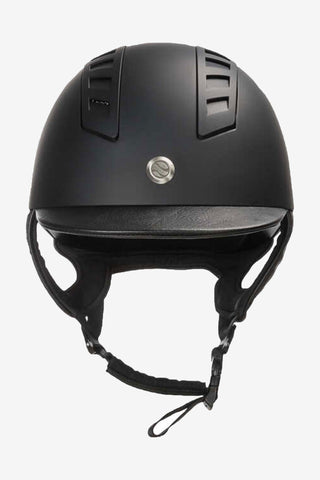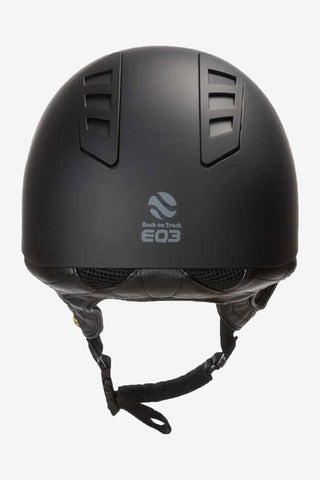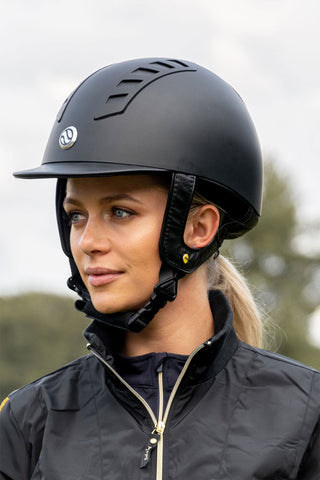Back on Track is proud to present the third generation EQ riding helmet with a glossy surface. Back on Track's design team has worked with the rider in focus to ensure a perfect fit and maximum safety.
Back on Track's EQ2 MIPS riding helmet, which was the predecessor to the EQ3 MIPS, was named the best riding helmet in 2014 by the insurance company Folksam's large helmet test. EQ3 Mips is now a significantly upgraded riding helmet, with a good & simple fit, that fits well on most head shapes.
What makes Back on Track's EQ3 riding helmet unique, compared to other riding helmets on the market, is that we have added MIPS to increase protection against angled impacts. You can read more about MIPS and how it works further down.
Compared to the test-winning EQ2 riding helmet, the Back on Track EQ3 riding helmet has:
- Improved fit
- Increased ventilation
- Low weight, for a safer & more comfortable experience.
The MIPS EQ3 riding helmet is approved according to the new safety standard CE VG1 01.040 2014-12.
The MIPS EQ3 riding helmet is available in fixed sizes; from size 53 up to 61.
MIPS is a patented technology that adds a low-friction layer between the head and the riding helmet, developed to reduce rotational violence on the brain during an angled impact.
Conventional riding helmets are tested by dropping them vertically onto a flat surface, and the helmets are also designed based on that test data. MIPS is designed to work according to how most accidents occur, with angled impacts on the head. MIPS changes the way of thinking about safety in riding helmets and other helmets.
The graph (see image) was generated using a final computer model, based on measurements taken from nine accelerometers in a "Hybrid III" crash test with a "dummy" head. The "dummy" wore a traditional helmet and a MIPS helmet, and then the test results were compared against each other. The model/image shows the stretching in the brain during a simulated angled impact when the "dummy" wears a traditional helmet, without MIPS, compared to a helmet with MIPS technology.
| Size | 53-61 |
Back on Track is proud to present the third generation EQ riding helmet with a glossy surface. Back on Track's design team has worked with the rider in focus to ensure a perfect fit and maximum safety.
Back on Track's EQ2 MIPS riding helmet, which was the predecessor to the EQ3 MIPS, was named the best riding helmet in 2014 by the insurance company Folksam's large helmet test. EQ3 Mips is now a significantly upgraded riding helmet, with a good & simple fit, that fits well on most head shapes.
What makes Back on Track's EQ3 riding helmet unique, compared to other riding helmets on the market, is that we have added MIPS to increase protection against angled impacts. You can read more about MIPS and how it works further down.
Compared to the test-winning EQ2 riding helmet, the Back on Track EQ3 riding helmet has:
- Improved fit
- Increased ventilation
- Low weight, for a safer & more comfortable experience.
The MIPS EQ3 riding helmet is approved according to the new safety standard CE VG1 01.040 2014-12.
The MIPS EQ3 riding helmet is available in fixed sizes; from size 53 up to 61.
MIPS is a patented technology that adds a low-friction layer between the head and the riding helmet, developed to reduce rotational violence on the brain during an angled impact.
Conventional riding helmets are tested by dropping them vertically onto a flat surface, and the helmets are also designed based on that test data. MIPS is designed to work according to how most accidents occur, with angled impacts on the head. MIPS changes the way of thinking about safety in riding helmets and other helmets.
The graph (see image) was generated using a final computer model, based on measurements taken from nine accelerometers in a "Hybrid III" crash test with a "dummy" head. The "dummy" wore a traditional helmet and a MIPS helmet, and then the test results were compared against each other. The model/image shows the stretching in the brain during a simulated angled impact when the "dummy" wears a traditional helmet, without MIPS, compared to a helmet with MIPS technology.
| Size | 53-61 |




